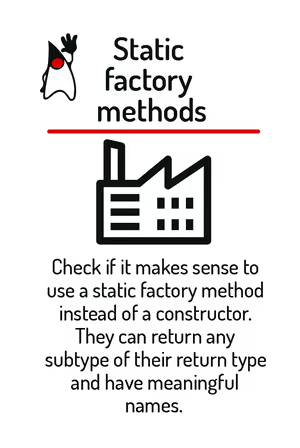Static factory methods

Static factory methods are an alternative to constructors that can make your code clearer, more flexible, and easier to maintain. Unlike constructors, they can have meaningful names, return subtypes, or even reuse existing instances. Use them when a simple constructor doesn’t communicate intent or when you want more control over object creation.
For example, a standard constructor:
public class User {
private final String name;
private final int age;
public User(String name, int age) {
this.name = name;
this.age = age;
}
}A static factory method can improve readability and flexibility:
public class User {
private final String name;
private final int age;
private User(String name, int age) {
this.name = name;
this.age = age;
}
public static User of(String name, int age) {
return new User(name, age);
}
public static User anonymous() {
return new User("Anonymous", 0);
}
}Now, the intent is clear:
User u1 = User.of("Alice", 30);
User u2 = User.anonymous();Advantages:
-
Meaningful names clarify object purpose.
-
Return subtypes or cached instances if needed.
-
Hide implementation details while keeping construction flexible.
-
Can avoid creating multiple identical objects via caching or singletons.
Practical habits:
-
Use static factory methods when constructors are ambiguous or overloaded.
-
Prefer them for immutable classes - they help express intent clearly.
-
Combine with
privateconstructors to prevent misuse.
Every commit should ask: “Could this object creation be clearer or more flexible?” Static factory methods make your code easier to read, maintain, and extend over time.